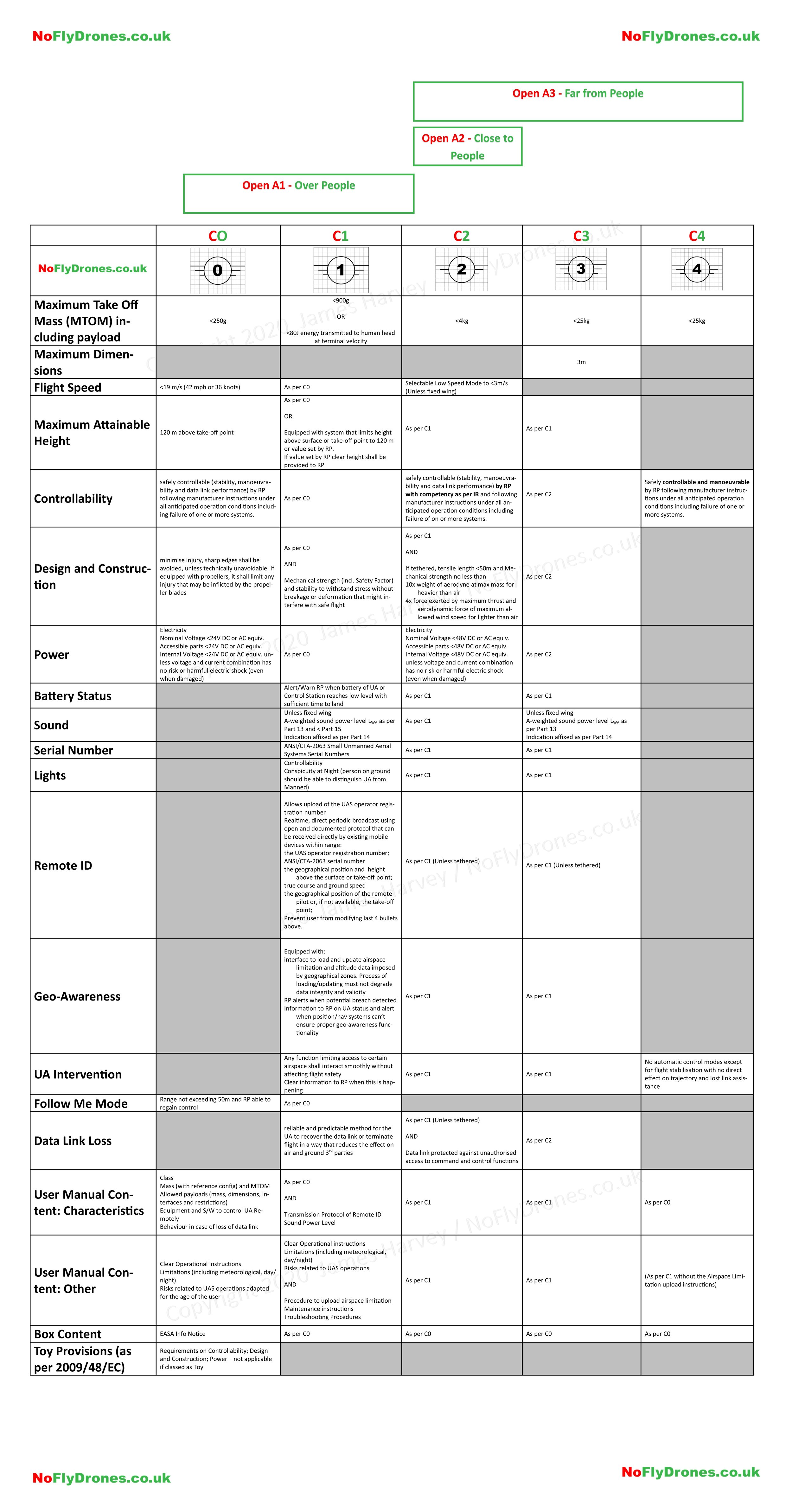Drone rules in the A1 Category if your drone is <500g
Quick Overview of Rules < 250g
C0/1/2/3/4 Drone and Open Category Mapping Summary
I’ve created a high level summary table which compares the rules applicable to each Class drone side by side. The parts in bold identify key differences I’ve spotted in the regulation. I’ve also mapped the Open Categories at the top of the table.
Small Print: These posts are a summary only, include my personal interpretation and are not intended to be a replacement for reading the actual rules.
The Open Sub-Categories
Update 9th June 2020: CAA have now decided the competency requirements for flying <500g drone as if it was a C1 device. Also added some clarification about distances from vessels, vehicles, and structured. They have also acknowledged that low speed mode privileges don’t apply to legacy aircraft. Text updated below.
I’ve already covered the three main categories (Open, Specific and Certified) but now I’m looking at the three sub categories of Open: A1, A2 and A3. They represent different scenarios of flying your drone:
A1 - Flying Over People
A2 - Flying Close to People
A3 - Flying Far away from People
In all open categories you are not allowed to fly over assemblies of people (in the UK this is usually taken as 1000 people or more).
The CAA has recently clarified that any distances stated should also apply to vehicles, vessels, and structures where you can’t be certain they are not occupied.
There are references in this post to particular classes of drone (e.g. Class C1, C2 etc.) this refers to the delegated regulation and I’ll cover specifically what these mean in another post once I’ve got my head round them.
Open A1 - Flying Over People
Open A1 Overview
Note: *CAA have now set this level to be the A2 CofC.
The drones that fit in this category are generally light in weight (< 900g), if you want to fly anything heavier than those that fit this bill then you’ll need to look at Specific or Certified.
In some circumstances you are allowed to fly over people. If you’re flying a Class C0 Drone (yes yet another category of something to understand), you’ve built it yourself (and it weights <250g with a max speed of 19m/s) or are flying a legacy <250g drone placed on the market before 1 July 2022) then you may overfly people. However if it’s a Class C1 Drone or a legacy drone <500g (until 30th June 2022 only) then you must not plan to intentionally overfly people.
With respect to keeping the aircraft within Visual Line of Site (VLOS), when flying in A1 you may use follow me mode up to a distance of 50m.
Competency is fairly light touch, for the smaller drones (<250g) you’ll need to be familiar with the drone user manual but if you’re flying a slightly heavier (but still within the A1 scale) you’ll need to have also passed the foundation training and online test (i.e. the CAA DMARES test).
Open A2 Category
Open A2 Overview
This category covers a slightly increased weight and does not allow any overflight of people in any circumstances. I believe the increased weight is linked to a general assumption that if a drone fails it will fall directly down rather than in any particular direction. Therefore this category allows flying close to people to but not directly overhead.
If you’re flying a Class C2 Drone or a legacy <2kg drone (until 30th June 2022 only) you may fly to within 50m (30m of Class C2) horizontally of people. This may be reduced to 5m if in low-speed mode (<3m/s). (Note: any legacy aircraft with a similar low speed mode can not take advantage of this distance reduction).
As with A1, the remote pilot must be familiar with the user manual but to fly close to people the operator will be required to hold an A2 Certificate of Competency (known as an A2 CofC).
Open A3 Category
Open A3 Overview
This category presents the lower end of risks of drone operations. It’s essentially for flights clear of people, buildings etc. Class C2, C3 and C4 drones may be used in this category. It also covers any legacy drones <25kg. Similar to A1, you’ll need to have also passed the foundation training and online test (i.e. the CAA DMARES test).
Next I’ll cover the general rules applicable to all Open Category flights, like heights, age, etc.
Small Print: These posts are a summary only, include my personal interpretation and is not intended to be a replacement for reading the actual rules.








